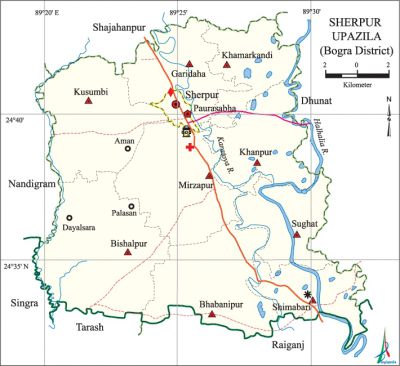Sherpur Upazila
Sherpur Upazila (bogra district) area 295.93 sq km, located in between 24°32' and 24°44' north latitudes and in between 89°20' and 89°32' east longitudes. It is bounded by shahjahanpur upazila on the north, raiganj and tarash upazilas on the south, dhunat upazila on the east, nandigram and singra upazilas on the west.
Population Total 332825; male 165527, female 167298; Muslim 301519, Hindu 30726, Buddhist 9, Christian 81 and others 490. Indigenous community such as santal belongs to this upazila.
Water bodies Main rivers: karatoya, Halhalia.
Administration Sherpur Thana was formed in 1962 and it was turned into an upazila in 1983.
| Upazila | ||||||||
| Municipality | Union | Mouza | Village | Population | Density (per sq km) | Literacy rate (%) | ||
| Urban | Rural | Urban | Rural | |||||
| 1 | 10 | 223 | 322 | 54082 | 278743 | 1125 | 53.9 (2001) | 39.2 |
| Municipality | ||||||||
|
Area (sq km) |
Ward |
Mahalla |
Population |
Density (per sq km) |
Literacy rate (%) | |||
| 6.74 (2001) | 9 | 19 | 25152 | 3319 (2001) | 74.5 | |||
| Upazila Town | ||||||||
|
Area (sq km) |
Mouza |
Population |
Density (per sq km) |
Literacy rate (%) | ||||
| 1.27 (2001) | 5 | 28930 | 18169 (2001) | 51.6 | ||||
| Union | ||||
| Name of union and GO code | Area (acre) | Population | Literacy rate (%) | |
| Male | Female | |||
| Kusumbi 57 | 9848 | 17136 | 17674 | 41.0 |
| Khanpur 47 | 7289 | 15672 | 15636 | 36.6 |
| Khamarkandi 38 | 5469 | 10754 | 10820 | 36.2 |
| Garidaha 28 | 6148 | 24141 | 24370 | 46.4 |
| Bishalpur 19 | 13152 | 13514 | 13731 | 37.3 |
| Bhabanipur 17 | 9056 | 12746 | 12802 | 39.5 |
| Mirzapur 66 | 5681 | 10331 | 10489 | 34.5 |
| Shimabari 85 | 5121 | 13020 | 13039 | 40.9 |
| Sughat 95 | 6027 | 13397 | 13994 | 37.7 |
| Shah-Bandegi 77 | 3518 | 22214 | 22193 | 44.4 |
Source Bangladesh Population Census 2001 and 2011, Bangladesh Bureau of Statistics.

Archaeological heritage and relics Sirajnagar Mosque, Sher Shah Mosque, Kherua Mosque, Bhabanipur Kali Mandir, Gobinda Rai Mandir.
War of Liberation On 25 April 1971 the Pak army abducted 32 innocent people and took them to the Itakhola mass killing site and shot 25 of them dead. On 26 April they also killed more than three hundred innocent Bangalis at a place near the Ghoga Bridge. On the same day the Pak army brutally tortured to death 26 people at village Darimukunda. Besides, in May the Pak army killed more than one hundred innocent people at village Kallani. One of the notable operations carried out by freedom fighters of the upazuila was their attack on the Sherpur police Station. There is a mass killing site at Baghra Colony.
For details: see শেরপুর উপজেলা, বাংলাদেশ মুক্তিযুদ্ধ জ্ঞানকোষ (Encyclopedia of Bangladesh War of Liberation), বাংলাদেশ এশিয়াটিক সোসাইটি, ঢাকা ২০২০, খণ্ড ৯।
Religious institutions Mosque 461, temple 65, church 1. Noted religious institutions: Dhar Mokam Mosque, Sher Mokam Mosque.
Literacy rate and educational institutions Average literacy 43.0%; male 47.0%, female 39.1%. Educational institutions: college 7, technical college 6, secondary school 49, primary school 119, kindergarten 20, madrasa 104. Noted educational institutions: Sherpur College (1967), Chonka Bilateral High School (1956), Sherpur Diamond Jubilee High School (1968), Palli Unnayan Academy Laboratory School and College (1985), Shahidia Ali Madrasa (1937).'
Newspapers and periodicals Weekly: Aajker Sherpur, Panchanadir Teere, Uttaranchal Barta,; irregular: Shastha Banglar Mukh, Sharad Argha, Janatar Samgram.
Cultural organisations Library 5, club 67, theatre group 1, cinema hall 3, cultural organisation 5, playground 20.
Tourist spots Palli Unnayan Academy' Tourist Centre, Soudia Park City Amusement Centre.
Main sources of income Agriculture 61.33%, non-agricultural labourer 2.97%, industry 1.44%, commerce 14.50%, transport and communication 4.47%, service 5.79%, construction 1.88%, religious service 0.16%, rent and remittance 0.27% and others 7.19%.
Ownership of agricultural land Landowner 50.08%, landless 49.92%; agricultural landowner: urban 31.78% and rural 53.29%.'
Main crops Paddy, wheat, jute, maize, mustard, kalai, betel leaf, potato, onion, vegetables.
Extinct or nearly extinct crops Sugarcane, kaun, china.
Main fruits Banana.
Fisheries, dairies and poultries Fishery 32, dairy 181, poultry 172, hatchery 1.
Communication facilities Pucca road 104 km, semi-pucca road 23.5 km, mud road 500.5 km.
Extinct or nearly extinct traditional transport Palanquin, dhuli.
Noted manufactories Rice mill 516, saw mill 44, flour mill 251, oil mill 12, ice factory 10, cement factory 1, cold storage 1.
Cottage industries Goldsmith 72, blacksmith 335, potteries 66, weaving 460, embroidery 547, bamboo and wood work 675.
Hats, bazars and fairs Hats and bazars are 34, fairs 7, most noted of which are Sherpur Hat, Mirzapur Hat, Ranir Hat, Bhabanipur Hat, Sukhat hat, Chandaikona Hat, Kellapushir Mela, Rani Bhabani Mela and Bijoy Dashami Mela.
Main exports Paddy, wheat, maize, betel leaf, banana, vegetables.
Access to electricity All the wards and unions of the upazila are under rural electrification net-work. However 43.4% of the dwelling households have access to electricity.
Sources of drinking water Tube-well 93.7%, tap 3.8% and others 2.5%.
Sanitation 71.3% of dwelling households of the upazila use sanitary latrines and 21.8% of dwelling households use non-sanitary latrines; 6.9% of households do not have latrine facilities.
Health centres Upazila health centre 1, family planning centre 9, satellite clinic 2, clinic 8, veterinary hospital 2. Noted health centre: ABC Eye Hospital 1.
Natural disasters Numerous people were victims of the earthquake of 1885.
NGO activities Operationally important NGOs are brac, asa, thengamara mahila sabuj sangha, Swanirvar Bangladesh. [Md. Sirajul Islam]
References Bangladesh Population Census 2001 and 2011, Bangladesh Bureau of Statistics; Cultural survey report of Sherpur Upazila 2007.
